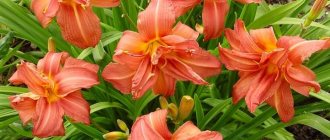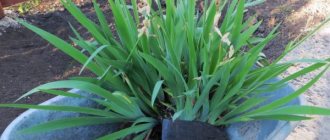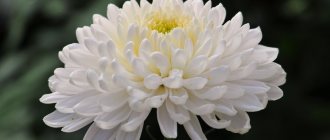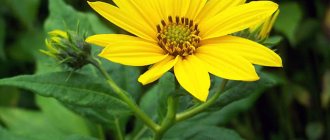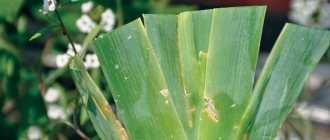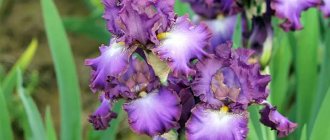The unusual bright beauty of irises and the almost unlimited possibilities of using them in the garden make this flower a favorite of designers. Single groups and mixed plantings, single-color and variegated flower beds, an excellent combination with the decorative elements of the site - all these are undeniable advantages of the view.
There are more than 800 species and varieties of this plant, which got its name from the ancient Greek “rainbow” and fully justifies it. Irises (killer whales, cockerels) come in one color, bicolor and iridescent. According to their sizes, they are divided into high (from 0.7 m), medium (up to 0.7 m) and low (up to 0.4 m). The density of their petals varies, from translucent to waxy, the shape is regular, wavy, corrugated, with patterns.
Plants fit well into any style of landscape design, take root on rocky slopes, and are unpretentious in care. Low-growing varieties will become an attractive decoration of garden paths and borders. Tall irises look natural around ponds and decorative pools.
Irises in the landscape design of a summer cottage
Irises have a special place in landscape design. Exquisite flowers create spectacular compositions as a monoculture and are very naturally combined with plants of other species . If there is a pond on the site, they will be an excellent addition to it.
Irises are heterogeneous in their color: in one flower, a certain color is revealed in the entire palette of shades, which is emphasized by contrasting inclusions. For example, there are gold veins on a blue background. The main colors of plants are blue, violet, blue. Irises can be single-colored or bicolored, tall or dwarf.
Miniature varieties will decorate a hill or rockery - a small rocky flower garden. The beauty of light stones is emphasized by plants in dark colors: burgundy, brown, rich purple. Yellow and blue iris will look beautiful against the backdrop of contrasting creeping juniper. Irises next to a beautiful garden bench, fountain or elegant lantern will create a pleasant atmosphere .
Irises are planted along various paths in the garden ; they look harmonious both on one side and on both sides. This type of planting is called rabatka. An interesting solution would be to plant iris against the background of the wall of a gazebo or terrace, especially when ondulin in a harmonious color - green or brown - is used as a roofing.
Types of irises and their use in landscape design
All irises are combined into two main groups:
- bearded: their outer petals have hairs like a beard. They feel more comfortable in dry areas with plenty of sun;
- beardless: distinguished by the presence of yellow spots. They grow best in the shade, on damp soils, and near water bodies.
In these photos you see the sophistication, grace and originality of each flower, which so attract designers.
Siberian iris
The Siberian iris differs from other species in having smaller flowers, but growing in greater numbers. They are resistant to disease, not picky about soil composition, adapt to different conditions, and tolerate moist soil well. Plant height is 0.3-1 m. The color is usually blue, lilac, light blue. Over time, the plants transform into shrubs. A good place for them is paved curved paths.
They go well with daylilies, delphiniums, and kupavkas. They look better on lawns as tapeworms. You can plant several varieties on the lawn, supplementing them with peonies or oriental poppies.
Designers often decorate ponds and streams with Siberian irises . The long leaves blend in with the water and the flowers give a beautiful reflection.
Bearded irises
Bearded irises are characterized by the presence of hairs from the inside of the outer petals. Where the petal plate bends, they resemble a beard. These varieties are quite whimsical and require large spaces for further growth. Abundant flowering is observed when the plant already has 7 to 9 leaves. There are low-growing, standard and tall types.
Swamp iris
Swamp iris, or calamus, grows on a very damp bank, near the water itself or even in shallow water, where the depth reaches no more than 0.3-0.4 m. It must be planted in a plastic container with holes, this prevents rapid growth . Under optimal conditions, it can reach a height of 1.7-2 m; there are also low-growing varieties - up to 0.5 m. The flowers are usually yellow, cream, white, hidden in long greenery.
At minimal cost, the flower pleases gardeners with its brightness and love of life. For its good health it requires lighting, fertilizing and timely watering. Swamp, or yellow, iris is used in decoration:
- compositions in which there is an abundance of trees and bushes;
- green barriers and hedges;
- tapeworms;
- flower beds with one type of plant;
- rows along the shores of lakes and ponds.
Yellow shades look very beautiful in combination with blue and its shades. When creating compositions in landscape design, these plants are grouped around a tall specimen, creating a geometric figure. It is better to plant silt on borders in small groups of 2-3 flowers.
Dwarf irises
Low-growing plants are often used by gardeners to create rock gardens, slides, and rock gardens . They benefit from plants that live for several years and have gray or silver foliage. They are planted in several types at once, so that they match in color.
An effective planting method is to plant dark species in the foreground, while light ones serve as the background. The trees in the background beautifully highlight the delicacy of the flowers.
Iris reticulum
Because of its early flowering, this delicate species of irises is also called snowdrop irises. They symbolize the arrival of warmth and spring. Their height is up to 15 cm, after flowering they grow sharply and reach 50-60 cm. With their help you can decorate borders, edges of flower beds, paths .
It is better to place the bulbs on the south side of the stones; the plants need sun for good growth. The variety of species and varieties of reticulated iris, or iridodictium, allows you to create a rich and original flower bed . The proximity to primrose, hyacinths, and crocuses is suitable for it; it will add sophistication and sophistication to the garden plot.
Border irises in landscape design
For spectacular decoration of borders, dwarf plant species are used . Unpretentious irises that produce succulent flowers successfully cope with this task.
You must first prepare the place where you plan to plant them: dig up and remove weeds. The soil should be light, with drainage. A strip about half a meter wide is formed. Raise the soil from one edge to the middle, make grooves for water drainage - these flowers do not like stagnant water and die.
To create a border, it is better to use plants of the same variety and maintain monochrome.
Iris flower beds: flower beds, iridariums, modules
The color palette of irises is very diverse. Thanks to this, in landscape design you can create lush and impressive-looking compositions from iris. Each variety blooms at its own time, so they can be selected so that the arranged flowerbed surprises with its colors throughout the flowering period - from May to July.
From iridescent plants you can create an original bright flower bed or a small garden - iridarium . It is very popular in garden decoration due to the wide range of plant possibilities and is close in size to an average flower bed. Plants are planted in groups, leaving sufficient gaps between them to allow for the growth of the bed. It is also convenient to walk along them for those who want to enjoy the blooming irises up close. For greater attractiveness, it is better to mulch the open soil of the paths, that is, sprinkle with wood chips or previously crushed tree bark. Other plants and decorative elements will add originality to the iridariums: benches, decorative pools, fountains, arches.
The potential of flowers will be revealed by modular planting. Typically, modules in the shape of a rectangle or square are used. The modules can be framed with curbs: concrete, brick, wood, or paths made of paving slabs.
To create a luxurious flower garden, recommendations from experts will come in handy:
- for two-color varieties, a smooth, monochromatic background is used, for example, a lawn;
- multi-colored crops look beautiful next to conifers and flora with pale leaves;
- It is important to maintain certain intervals between varieties: small irises look better with a distance of 10-15 cm, medium ones - 15-20 cm, tall ones - 35-40 cm;
- small varieties are placed in front, tall ones in the back.
A tapeworm will be an effective decoration for a dacha or country house. These are single compositions in the garden plot . Usually these are single-species irises of various shades. If they are different in height, this will add zest to the composition. The background will be a lawn or a non-flowering ornamental shrub.
Variegated multi-colored flowers, collected in one place, will merge into one spot, while dark plants next to light ones will visually enhance each other.
Mono-colors planted in groups look beautiful. The void between the plants will be filled with gravel, which will also ensure ease of maintenance. It is not recommended to plant flowers in a single row - asymmetry emphasizes them more favorably, and the presence of ornamental grasses will add zest.
When laying out a flower garden or flower bed, you need to take into account some nuances:
- there should not be buds of the same color in one group - this makes the flower bed dull and unattractive;
- varieties of pale shades lose out against the background of bright roses and peonies;
- variegated and richly colored iris look better separately.
FLOWERS - decorative neighbors
Roses and sage make great neighbors!
Decorative sage (salvia) is a wonderful companion for roses. Even visually oblong sage flowers will emphasize the round shapes of beautifully blooming roses. If you choose the well-known variety of salvia “Blue Queen”, then in addition you can attract many butterflies to your flower garden. The May Night variety of sage may also be a good option.
FENNEL BRONZE
For some gardeners, the rose plays a more important role than just an object of admiration. Many people use rose petals in the creation of medicines, as they contain a large amount of immune-strengthening vitamin C. If you are one of those who are primarily interested in the medicines of ornamental plants, then we suggest that you choose a flowerbed neighbor as useful as the rose itself . Pink fennel texturally enhances the beauty of rose bushes. Its yellow umbrellas attract many beneficial insects, including butterflies.
Fennel
WORMWORM
The silvery blue leaves of wormwood are the perfect backdrop for rose bushes. However, it must be remembered that all varieties of wormwood require excellent soil drainage. However, good drainage will not harm rose bushes either.
Roses and wormwood - unexpected, but very beautiful!
COREOPSIS
Coreopsis
Roses are often planted next to coreopsis, which look somewhat similar to roses, but are famous for their longer flowering time. Some of the coreopsis varieties bloom for 3 months or more.
RUDBECKIA
Don’t forget about the long-loved and well-known rudbeckia. It also makes an excellent bed partner for your roses. The different colors of rudbeckia will help you choose the perfect color combinations for your flower bed.
PHLOXES
Planting phlox next to roses is also a great idea because these flowers can later be used to create stunning bouquets. However, when choosing phloxes as neighbors for rose bushes, it is necessary to remember that there is sufficient distance between the flower bushes, since both roses and phloxes suffer from powdery mildew, which appears due to poor air circulation.
IRISES
Irises can be an excellent option for those who like to choose colors and experiment with colors, because the variety of irises can provide many color combinations to highlight the color of roses or, conversely, play on contrast. Caring for irises is very simple and will not be difficult.
Irises and roses
Tall irises in landscape design
The tallest varieties of irises reach a meter and attract attention. They are used to create long-range or middle plans of flower beds and other compositions . The background for them is thujas, junipers, ornamental shrubs, and berries.
A group of tall irises will look beautiful on the lawn, as well as on an area fenced off from the lawn grass with a border strip. You can choose peonies, lilies, oriental poppies as neighbors. Asters and phlox are suitable for the background.
Lilies and hostas
This very successful combination is especially loved by landscape designers. Hostas cover unsightly lily stems with their large leaves. They grow quite slowly and do not cause gardeners problems with weeding, and the large leaves of one bush can cover an entire square meter of area around the lilies. To prevent the soil in the flowerbed from being empty in the spring, because hostas wake up quite late, plant bulbs of snowdrops, muscari or crocuses on it. They do not bloom for long, so the hosta leaves that grow in summer will not disturb them. With a minimum of effort put in at the very beginning, such a flowerbed will look well-groomed and decorative for many years. As they say, plant it and forget it.
Combination of irises with other plants in landscape design
Irises are peaceful plants and share space with other varieties of flora without aggression. An important point when planting in this case is that they grow and can displace them, so species with a deep root system should grow nearby. Experts do not recommend planting them very close to trees and aggressive plants that have a powerful root system.
Neighborhood with phlox creates a risk of infection with rust, which they often suffer from. This risk can be avoided if all plants are preventively treated against fungal diseases.
Iris and tulips get along well, despite the similarity of the root system. It is better to plant them in contrast, not just the same tones, and leave free space for further growth.
Gardeners choose spirea, lupins, conifers, and pansies for planting in the neighborhood.
For tall varieties, barberries, forsythia, bladderworts, and, most interestingly, gooseberries and currants are perfect neighbors. Dwarf trees coexist with saxifrage, creeping phlox, and mountain pines.
Irises and peonies
It is characteristic of peonies that during their flowering they become a bright spot against the background of other plants, while after flowering they themselves become the background. Their large inflorescences harmoniously combine with iris flowers , especially if they are well matched in color: irises look good with white and coral peonies.
Irises and daylilies
Combining irises and daylilies will ensure longer flowering of the entire flowerbed . This tandem has its advantages:
- the root system of the species is at different levels, so the plants do not interfere with each other’s development;
- lilies do not oppress irises and are considered good neighbors;
Flower care
Flowers are planted in holes. For bearded species, it should be shallow. The roots are straightened horizontally and sprinkled with soil. Beardless varieties can be buried 5-7 centimeters. The distance between the holes ranges from 50 to 15 centimeters, depending on the height of the stem.
Garden crops need care in the form of:
- regular watering;
- fertilizing with liquid potassium-phosphorus fertilizers;
- weeding;
- careful loosening of the soil.
A special feature of care is that plants need to be fed only before flowering..
